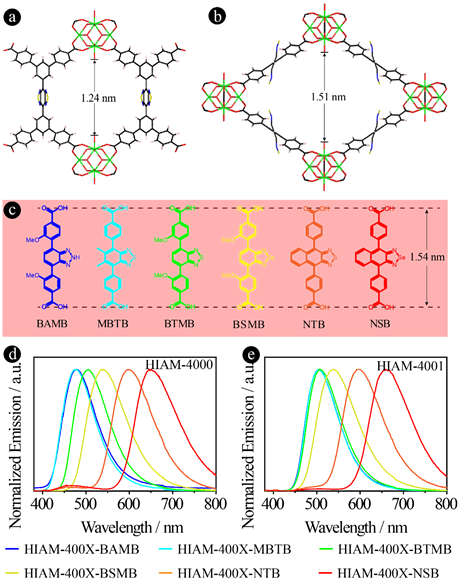Recently, Dr. Liu Xiaoyuan Research Group of Hoffmann Institute of Advanced Materials has made significant progress in the preparation and property research of luminescent metal-organic frameworks (LMOFs) materials. The results were published in theJournal of The American Chemical Society with the title "Linker Engineering toward Full-Color Emission of UiO-68 Type Metal-Organic Frameworks"(https://pubs.acs.org/abs/10.1021/jacs.1c04810) on July 9, and inAngewandte Chemie with the title "Tuning and Directing Energy Transfer in the Whole Visible Spectrum through Linker Installation in Metal-Organic Frameworks"(https://onlinelibrary.wiley.com/doi/10.1002/anie.202110531) on September 17.
LMOFs demonstrate strong potential for a broad range of applications such as solid state luminescence, biological detection and imaging due to their tunable compositions and structures. However, the methodical control of the LMOF emission properties remains a great challenge.
Herein, to solve the challenge mentioned above, Dr. Liu Xiaoyuan Research Group, based on a large number of literature searches, designed and synthesized a series of 2,1,3-benzothiadiazole and its derivative-based dicarboxylic acids as luminescent linkers (see the figure below) to show that linker engineering is a powerful method for systematically tuning the emission behavior of UiO-68 type metal-organic frameworks (MOFs) to achieve full-color emission. To address the fluorescence self-quenching issue caused by densely packed linkers in some of the resultant UiO-68 type MOF structures, Dr. Liu Xiaoyuan Research Group applied a mixed-linker strategy by introducing non-fluorescent linkers to diminish the self-quenching effect of LMOFs. Steady-state and time-resolved photoluminescence (PL) experiments reveal that aggregation-caused quenching can indeed be effectively reduced as a result of decreasing the concentration of emissive linkers, thereby leading to significantly enhanced quantum yield and increased lifetime. This research provides a new idea for systematically regulating the luminous properties of MOFs, and the corresponding results were published in theJournal of The American Chemical Society, which was mainly completed by Wu Shenjie, research assistant of Hoffmann Institute of Advanced Materials under the guidance of Dr. Liu Xiaoyuan and the careful direction of Prof. Li Jing.

In the photosynthesis system, the absorption and energy transfer of light are trigger steps for the conversion of luminous energy into bioenergy, which are crucial to the life process. The construction of bionic light absorption system is a strong guide for studying the mechanism of energy transfer process and improving the light utilization efficiency of artificial photosynthesis system.
MOFs can be used as an absorbing body to study the energy transfer process due to their tunable structure and composition, and accurate and controllable crystal structures. However, the existing research ideas are mainly focused on the pillar-layered MOFs and mixed-linker MOFs system (see the figure below). Limited by the types of luminescent linkers, the energy transfer of the two systems is often limited to specific spectral ranges, making it difficult to study the energy transfer within the full visible spectral range. On the basis of preliminary work (J. Am. Chem. Soc. 2021, 143, 28, 10547-10552), the researchers of Hoffmann Institute of Advanced Materials first prepared HIAM-400X, five LMOFs based on tetradentate carboxylic acids as organic linkers. The luminous wavelength of the HIAM-400X series covers the entire visible light band, which can be used as a pristine scaffold for linker installation.

After clarifying the crystal structures of HIAM-400X series and the distance between linker metal sites, six full-color emissive 2,1,3-benzothiadiazole and its derivative-based dicarboxylic acids (L) were successfully installed into HIAM-400X matrix to form HIAM-400X-L. Due to the different absorbing and luminous properties of HIAM-400X and L, in the HIAM-400X-L system formed after the insertion of L, the controlled adjustment of energy transfer from HIAM-400X to L or from L to HIAM-400X can be realized, and the adjustment of energy transfer within the whole visible spectrum range can be further realized.

This study provides a new strategy for studying energy transfer, achieves controllable adjustment of energy transfer throughout the visible spectral range, providing new ideas for the objective-oriented design and application of new absorbing materials. The paper was selected as Hot Paper by editors due to the high identity of peer experts. The study was published inAngewandte Chemie,which was mainly completed by research assistant Ren Daming and postdoctor Xia Hailun of Hoffmann Institute of Advanced Materials under the guidance of Dr. Liu Xiaoyuan and Prof. Li Jing.
The completion of the above studies was strongly supported by Shenzhen Polytechnic, and funded by the Youth Project of Guangdong Regional Joint Fund and Doctoral Initiation Project of Shenzhen Science and Technology Planning.
(Hoffmann Institute of Advanced Materials, SZPT)
 School Motto:
School Motto:
 Search
Search
 School Motto:
School Motto:
 Search
Search